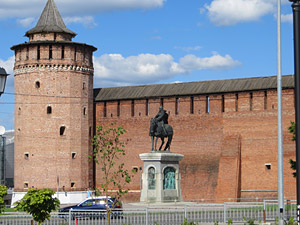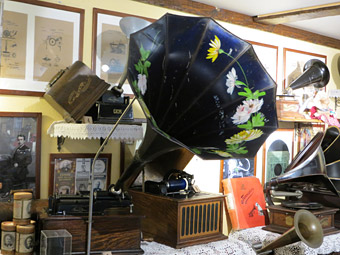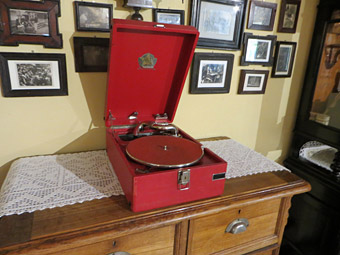
Electronic english version since 2022 |
The newspaper was founded in November 1957
| |
Kolomna. Immersion in history
Kolomna is a little younger than Moscow, this year it turned 845 years old. For a long time it has been an important strategic and trading centre with a rich history.
In the Kolomna meadows in 1380, Prince Dmitry Ivanovich of Moscow held a review of the troops, with whom he set out on a campaign against the hordes of Mamai. As we know, the campaign ended with a victory on the Kulikovo field and Dmitry Ivanovich received the nickname Donskoy. In memory of this victory, the Monastery of the Nativity of the Holy Mother of God was founded in Kolomna, a little later - Epiphany Staro Golutvin Monastery, the place for which, according to legend, Sergius of Radonezh himself indicated. In 1552, Kolomna again became a rallying centre when Ivan the Terrible began preparations for a campaign against Kazan. And its capture was marked by the founding of the Brusensky Assumption Monastery in Kolomna.
 Today, there are 4 monasteries as well as 49 churches and temples in the city - and this is for 135 thousand citizens! In this, I think, Kolomna is ahead of Moscow and what exactly citizens of Kolomna are proud of is the height of the walls of their Kremlin. Outwardly similar, also built by Italians, decorated with the familiar "swallowtails", Kolomna walls rise to 21 meters, while the walls of the capital's Kremlin have a height of 5 to 19 meters. Unlike the Moscow Kremlin, the Kolomna Kremlin has never been captured, although it was stormed three times by Tatar-Mongols. And the last detail is that it is the only residential Kremlin in Russia, although today two partially preserved and restored sections and seven towers have remained from the almost two-kilometer perimeter, but on its former territory, among temples and monasteries, urban development has also been preserved, where museums, hotels, souvenir shops, cafes and restaurants are located along with residential buildings.
Today, there are 4 monasteries as well as 49 churches and temples in the city - and this is for 135 thousand citizens! In this, I think, Kolomna is ahead of Moscow and what exactly citizens of Kolomna are proud of is the height of the walls of their Kremlin. Outwardly similar, also built by Italians, decorated with the familiar "swallowtails", Kolomna walls rise to 21 meters, while the walls of the capital's Kremlin have a height of 5 to 19 meters. Unlike the Moscow Kremlin, the Kolomna Kremlin has never been captured, although it was stormed three times by Tatar-Mongols. And the last detail is that it is the only residential Kremlin in Russia, although today two partially preserved and restored sections and seven towers have remained from the almost two-kilometer perimeter, but on its former territory, among temples and monasteries, urban development has also been preserved, where museums, hotels, souvenir shops, cafes and restaurants are located along with residential buildings.
In the 14th and 15th centuries, the favorable location of Kolomna turned it into an important trading and transit centre. It becomes the second most important and wealthy city after Moscow in the Grand Duchy of Moscow, conducts a brisk trade with Kazan and Astrakhan, as well as develops numerous crafts. In the 18th century, industrial enterprises were built in Kolomna; it stands out among other cities near Moscow with a large number of stone residential buildings. True, enterprising merchants laid the foundation for this, secretly dismantling the Kremlin walls at night in order to use fine brick for new construction. And from the middle of the next century, the production of freight cars, then steam locomotives, was organized in the city. It was in Kolomna in 1869 that the first domestic steam locomotive was produced. It received the Grand Prix at the World Exhibition in Paris in 1900. Then the production of electric trams started. By the way, today, in the Moscow region only in Kolomna (!) trams run, as many as 10 routes and one more, excursion one, on which you can not only learn about the history of the city, but also make a wish that, as they say, comes true.
 And here in 1934, in the premises of the former silk-rolling factory, the Kolomna portable gramophone factory was opened. Moreover, the quality of the products was such that three years later the Kolomna gramophone was presented at the World Exhibition in Paris and was supplied to Afghanistan, India, China, Mongolia and other countries of Asia and the Middle East. Edison phonographs, gramophones of the Pate brothers, music boxes on metal discs, unique portable gramophones are presented in the rich collection of the Kolomensky Gramophone Museum - in everyday life and even in Russian literature, the name gramophone was assigned to it from the first deliveries of the products of the Pate brothers company to Russia. Here you can find out that the phonograph was the favorite invention of T. Edison and he himself was an Honorary Member of the Academy of Sciences of the USSR; what is the difference between a gramophone and a phonograph - in the first, the pickup head moves from the center to the edge of the plate, in the second - vice versa. The collection contains several samples of gramophones from the early 20th century by the English company Decca Grammophone, including copies in a steel bulletproof case used in the trenches of the First World War and on a portable gramophone captured during the Great Patriotic War, all the inscriptions are carefully erased, so it is impossible to recognize the manufacturer. The smallest pocket Swiss gramophone is stored here, toy English and German ones are presented, an exhibit with a cardboard tube with bright pictures to amplify the sound - it could be compactly folded into the gramophone case and in case of heat to be used as a fan. A portable gramophone, designed in the USA, was used in sermons by Jehovah's Witnesses to enhance the mystical effect, since it performed sermons only in a closed (!) form. There are miniature gramophones and phonographs of domestic production in the factories of Moscow, Leningrad, Vladimir and other cities.
And here in 1934, in the premises of the former silk-rolling factory, the Kolomna portable gramophone factory was opened. Moreover, the quality of the products was such that three years later the Kolomna gramophone was presented at the World Exhibition in Paris and was supplied to Afghanistan, India, China, Mongolia and other countries of Asia and the Middle East. Edison phonographs, gramophones of the Pate brothers, music boxes on metal discs, unique portable gramophones are presented in the rich collection of the Kolomensky Gramophone Museum - in everyday life and even in Russian literature, the name gramophone was assigned to it from the first deliveries of the products of the Pate brothers company to Russia. Here you can find out that the phonograph was the favorite invention of T. Edison and he himself was an Honorary Member of the Academy of Sciences of the USSR; what is the difference between a gramophone and a phonograph - in the first, the pickup head moves from the center to the edge of the plate, in the second - vice versa. The collection contains several samples of gramophones from the early 20th century by the English company Decca Grammophone, including copies in a steel bulletproof case used in the trenches of the First World War and on a portable gramophone captured during the Great Patriotic War, all the inscriptions are carefully erased, so it is impossible to recognize the manufacturer. The smallest pocket Swiss gramophone is stored here, toy English and German ones are presented, an exhibit with a cardboard tube with bright pictures to amplify the sound - it could be compactly folded into the gramophone case and in case of heat to be used as a fan. A portable gramophone, designed in the USA, was used in sermons by Jehovah's Witnesses to enhance the mystical effect, since it performed sermons only in a closed (!) form. There are miniature gramophones and phonographs of domestic production in the factories of Moscow, Leningrad, Vladimir and other cities.


The very design of the exposition attracts attention: the exhibits are not torn out of their usual habitat - they are carefully placed on woven napkins and runners lying on antique chests of drawers, whatnots, Singer sewing machines, improvised coasters from rare suitcases and cases for records, accompanied by many records, old photographs and newspaper articles. And what copies of the old covers for Soviet records are here - with calls to buy government domestic bonds, to save money in a savings bank, to insure one's furnishings, clothes, musical instruments and books against fire or to register radios! And a showcase with beautiful branded metal boxes with gramophone needles, a gramophone movie and how many more interesting things the guide will tell and put on some rare record, turning the gramophone handle 30 times so that the winding is enough for a long time.
The citizens of Kolomna carefully keep the memory of their famous fellow countrymen and celebrities who visited the city in monuments, memorial plaques and even graffiti. The first to name is the hereditary honorary citizen of Kolomna, Maria Nikolaevna Shevlyagina, who not only fulfilled the last will of her merchant husband that had bequeathed most of the capital for the construction of the city water supply and other charity, but also controlled the progress of construction. The problem of water supply in the city was acute: citizens always used the Moscow River, there were no wells, since the city stands on limestone. Over time, the polluted river became a source of contagious diseases. Artesian wells solved the problem. The water supply was opened in 1902, for the townspeople this utility service became free, such was the condition of Maria Nikolaevna. Grateful citizens of Kolomna in the same year placed commemorative cast-iron plates on the standpipes and the columns themselves were called Shevlyagin pools. A few years ago, next to one of them, a bust of M.N.Shevlyagina was solemnly installed.


Another native of Kolomna is better known - the writer I.I.Lazhechnikov, whose memory is immortalized in a museum in his family estate, a street on the territory of the Kremlin, a bust, the name of a cafe, graffiti on the wall of the library named after him. Kolomna merchants had the surname Lozhechnikovs, Ivan changed the letter "o" to "a" when he started to write. The choral conductor A.V.Sveshnikov was also born in Kolomna, A.I.Kuprin came to visit his sister, A.A.Akhmatova visited here and V.V.Erofeev studied at the Kolomna Pedagogical Institute for only six months, but the townspeople remember this as well (or maybe they just lure us, simple-minded tourists?), a native of the city is the actor L.A.Perfilov, who played episodic roles in 120 films, but we remember two of them well - Grisha "Six-to-nine" in "The meeting place cannot be changed" and a dissident chatlanin in "Kin-dza- dza".
There are 40 museums in Kolomna today, most of them are private ones and their employees are always willing to share their knowledge with every visitor. And the old, as the citizens themselves call it, Kolomna is very cozy: quiet streets with one-story houses, above them the chirping of swallows preparing to fly away and the smell of apples. Well, do you already want to see Kolomna or visit it again? Me for sure!
Olga Tarantina, photo by the author